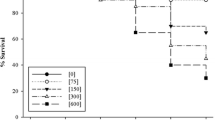Abstract
Four entomopathogenic nematode species, Steinernema carpocapsae, S. feltiae, Heterorhabditis bacteriophoraand H. megidis, were tested in a petri dish assay against larvae and adults of the hairy fungus beetle Typhaea stercorea. In general, adults were less susceptible than larvae and the LC50 decreased with the duration of the exposure to nematodes. S. carpocapsae was the most effective species against adult beetles (LC50 after 96 hours exposure =67 nematodes/adult). Against larvae S.carpocapsae and H. megidis were comparablyeffective with an LC50 of 30 and 55nematodes/larvae, respectively. S. carpocapsaewas tested at 70 and 100% RH against adults in baits of either chicken feed or crushed wheat, both supplemented with horticultural capillary matting pieces in order to obtain a wet weight of 50–60%. At70% RH no significant effect of the nematodes was obtained due to desiccation of the bait. In chickenfeed at 100% RH the mortality reached 80% with 500nematodes/adult. In wheat significant mortality was obtained only at 5000 nematodes/adult. Heavy growth of mould probably limited the nematode infection. When the bait was used in tube traps, desiccation and growth of mould was prevented, but nematode efficacy dropped to 4.4% in the traps and 12% in the surrounding litter.
Similar content being viewed by others
References
Boemare, N., C. Laumond and H. Mauleon, 1996. The entomopathogenic nematodebacterium complex: biology, life cycle and vertebrate safety. Biocontrol Sci.Technol. 6: 333–345.
Campbell, J.F. and R. Gaugler, 1993. Nictation behaviour and its ecological implications in the host search strategies of entomopathogenic nematodes (Heterorhabditidae and Steinernematidae). Behaviour 126: 155–169.
Campbell, J.F., E. Lewis, F. Yoder and R. Gaugler, 1996. Entomopathogenic nematode (Heterorhabditidae and Steinernematidae) spatial distribution in turfgrass. Parasitology 113: 473–482.
Caroli, L., I. Glazer and R. Gaugler, 1996. Entomopathogenic nematode infectivity assay: comparison of penetration rate into different hosts. Biocontrol Sci.Technol. 6: 227–233.
Dowdy, A.K. and W.H. McGaughey, 1994. Seasonal activity of stored-product insects in and around farm-stored wheat. J.Econ.Entomol. 87: 1351–1358.
Epsky, N.D. and J.L. Capinera, 1993. Quantification of invasion of two strains of Steinernema carpocapsae (Weiser) into three lepidopteran larvae. J.Nematol. 25: 173–180.
Erichsen, L.D., 1998. Development and Behaviour of three Species of Coleoptera in a Danish Chicken Broiler House. M.Sc. Thesis, Danish Pest Infestation Laboratory, Lyngby, and Department of Population Biology, Zoological Institute, University of Copenhagen, Denmark. pp. 36.
Funder, J.V., K. Arevad, J. Lodal and H. Mourier, 1992. Advisory work. Annual Report 1992. Danish Pest Infestation Laboratory, Lyngby, Denmark. pp. 25–35.
Geden, C.J., J.J. Arends and R.C. Axtell, 1987. Field trials of Steinernema feltiae (Nematoda: Steinernematidae) for control of Alphitobius diaperinus (Coleoptera: Tenebrionidae) in commercial broiler and turkey houses. J.Econ.Entomol. 80: 136–141.
Geden, C.J., R.C. Axtell and W.M. Brooks, 1985. Susceptibility of the lesser mealworm, Alphitobius diaperinus (Coleoptera: Tenebrionidae) to the entomogenous nematodes Steinernema feltiae, S.glaseri (Steinernematidae) and Heterorhabditis heliothidis (Heterorhabditidae). J.Entomol.Sci. 20: 331–339.
Geden, C.J., R.C. Axtell and W.M. Brooks, 1986. Susceptibility of the housefly Musca domestica (Diptera: Muscidae) to the entomogenous nematodes Steinernema feltiae, S. glaseri (Steinernematidae) and Heterorhabditis heliothidis (Heterorhabditidae). J.Med. Entomol. 23: 326–332.
Georgis, R., B.A. Mullens and J.A. Meyer, 1987. Survival and movement of insect parasitic nematodes in poultry manure and their infectivity against Musca domestica. J.Nematol. 19: 292–295.
Hagstrum, D.W., A.K. Dowdy and G.E. Lippert, 1994. Early detection of insects in stored wheat using sticky traps in bin headspace and prediction of infestation level. Environ. Entomol. 23: 1241–1244.
Hald, B., A. Olsen and M. Madsen, 1998. Typhaea stercorea (Coleoptera: Mycetophagidae), a carrier of Salmonella enterica serovar Infantis in a Danish broiler house. J.Econ.Entomol. 91: 660–664.
Hubert, J.J., 1992. Bioassay. Third edition. Kendal/Hunt Publishing Company, Iowa.
Ishibashi, N. and E. Kondo, 1990. Behaviour of infective juveniles. In: R. Gaugler and H.K. Kaya (eds), Entomopathogenic Nematodes in Biological Control. CRC Press, Boca Raton. pp. 139–150.
Jacob, T.A., 1988. The effect of temperature and humidity on the developmental period and mortality of Typhaea stercorea (L.) (Coleoptera: Mycetophagidae). J.Stored Products Res. 24: 221–224.
Kaya, H.K., T.M. Burlando and G.S. Thurston, 1993. Two entomopathogenic nematode species with different search strategies for insect suppression. Environ.Entomol. 22: 859–864.
Keiding, J., 1999. Review of the global status and recent development of insecticide resistance in field population of the housefly, Musca domestica (Diptera: Muscidae). Bull.Entomol. Res. 89 (Suppl. 1): S7–S67.
Koppenhöfer, A.M., M.E. Baur, S.P. Stock, H.Y. Choo, B. Chinnasri and H.K. Kaya, 1997. Survival of entomopathogenic nematodes within host cadavers in dry soil. Appl.Soil Ecol. 6: 231–240.
Mullens, B.A., J.A. Meyer and T.L. Cyr, 1987. Infectivity of insect-parasitic nematodes (Rhabditida: Steinernematidae, Heterorhabditidae) for larvae of some manure-breeding flies (Diptera: Muscidae). Environ.Entomol. 16: 769–773.
Peters, A., 1994. Interactions between insect defence mechanisms and entomopathogenic nematodes. IOBC WPRS Bull. 17: 43–47.
Peters, A. and R.-U. Ehlers, 1994. Susceptibility of Leatherjackets (Tipula paludosa and T. oleracea; Tipulidae; Nematocera) to the entomopathogenic nematode Steinernema feltiae. J.Invertebr.Pathol. 63: 163–171.
Poinar, G.O. Jr., G.M. Thomas, S.B. Presser and J. L. Hardy, 1982. Inoculation of entomogenous nematodes, Neoaplectana and Heterorhabditis, and their associated bacteria, Xenorhabdus spp., into chicks and mice. Environ.Entomol. 11: 137–138.
Renn, N., 1998. The efficacy of entomopathogenic nematodes for controlling housefly infestations of intensive pig units. Med.Vet.Entomol. 12: 46–51.
Renn, N., G. Barson and P.N. Richardson, 1985. Preliminary laboratory tests with two species of entomophilic nematodes for control of Musca domestica in intensive animal units. Ann. Appl.Biol. 106: 229–233.
SAS Institute, 1989. SAS/STAT User's Guide, Version 6, Fourth edition. SAS Institute Inc., Cary, North Carolina.
Sigma Stat, 1994. SigmaStat for Windows, User's Manual. Jardel Scientific, United States.
Author information
Authors and Affiliations
Corresponding author
Rights and permissions
About this article
Cite this article
Svendsen, T.S., Steenberg, T. The potential use of entomopathogenic nematodesagainst Typhaea stercorea. BioControl 45, 97–111 (2000). https://doi.org/10.1023/A:1009966918472
Issue Date:
DOI: https://doi.org/10.1023/A:1009966918472



